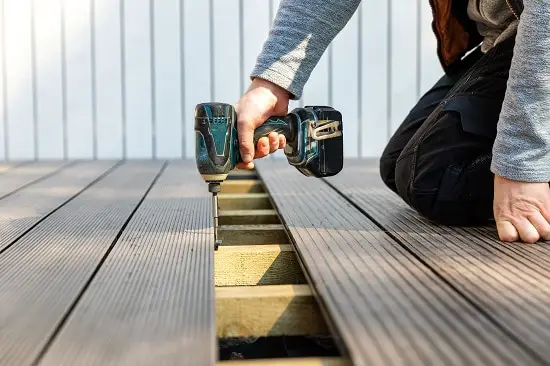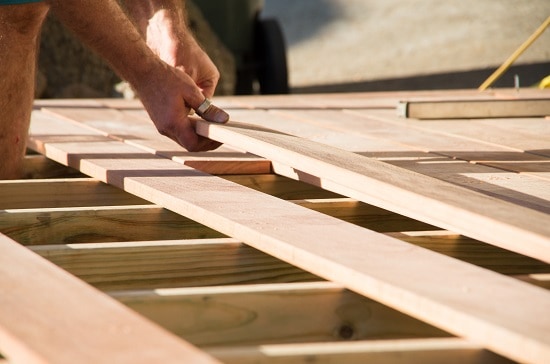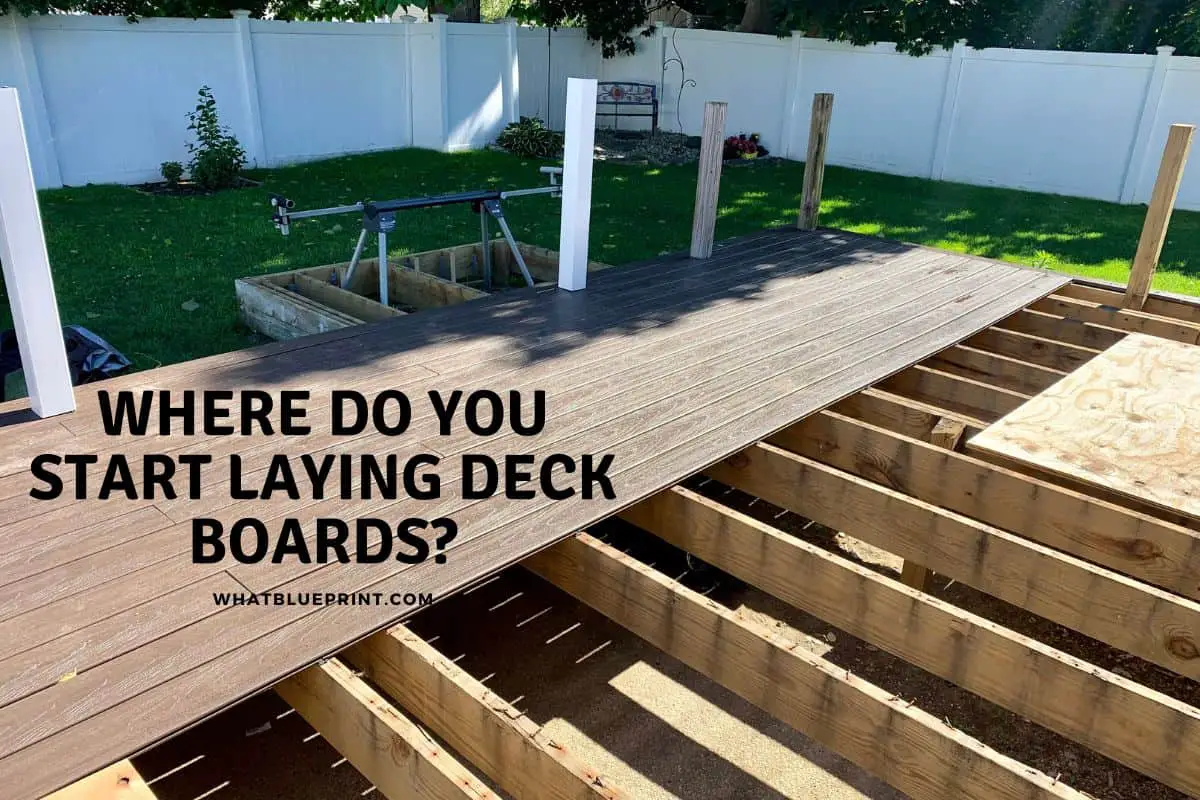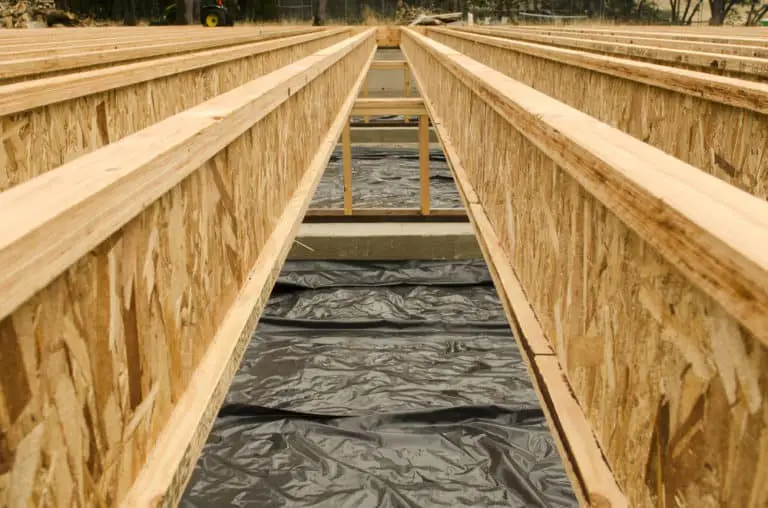Where Do You Start Laying Deck Boards?
Installing a deck is one of the most rewarding DIY projects in existence. However, it is not necessarily as easy as it looks. Several considerations go into ensuring that the end result of your deck installation is as good as it could possibly be. Where you start laying the boards makes a big difference to the end result.
You can start laying your deck boards at the edge of the house, in the middle of the deck, or at the outer perimeter of the deck. Beginning on the outer perimeter may ensure a neater result overall. Still, the best option for your circumstances will depend on your specific project.
By carefully measuring and laying your deck boards in the best possible way for your specific deck project, you will ensure that your end result is as aesthetically pleasing and practical as possible. By putting in some extra effort to ensure that your deck is laid correctly and accurately, you will be assured of a successful deck project from a practical and aesthetic point of view.

Where Do You Start Laying Deck Boards?
There are generally three options when it comes to the best place to lay your deck boards. Each option has its advantages and disadvantages, but there will be specific projects where one option is far better than another.
It’s extremely important to lay your decking boards properly to ensure that the deck looks good while retaining the integrity of the entire structure.
Start laying decking from the House edge.
Your first option is to begin laying the boards at the house’s edge. This will make the installation process easier, as you won’t struggle to fit the final board against the edge of the house. However, it may result in a need to cut the board at the perimeter of the deck to be a little narrower. This cut board can be aesthetically displeasing as well as impractical.
If you choose to start laying the boards at the house’s edge, place the first board ¼” from the house’s siding.
Lay Decking from the Middle of the Deck
Your next option is to begin laying your deck boards in the middle of the deck. This option is particularly useful if your deck comprises two sections, and the middle board forms the border between the two sections. For example, your deck could be only 6 feet wide up to a point before becoming 12 feet wide.
In this case, you could install your first board in the middle between the narrow section and the wide section. This board will form the outer perimeter of your narrow section of decking while creating a neat transition between the narrow section and wide section.
Lay Decking the the Outer Edge of the Deck
Your third option is to begin laying your deck boards from the deck’s perimeter. This option will usually give you the best result in terms of aesthetics. You are guaranteed a full-width board at the outermost edge of your deck.
This will ensure a neat, finished look overall. However, you may encounter difficulties placing the last boards closest to the house. The final deck board may need to be cut narrower to fit into place. You will also be assured of precise spacing and an overall refined aesthetic. If you use composite decking boards then laid well they can last for over 25 years

Other Considerations For Laying Deck Boards
When laying deck boards, you must always ensure that the ends of the deck boards each sit on a joist. This will ensure the safety and structural integrity of the deck structure. In most cases, you will lay your deck boards parallel to the wall of the house, as the joists usually run perpendicular to the house.
It’s also worthwhile trying to ensure that your deck boards span the entire width of the deck to avoid having significant gaps between boards. If the deck is too long for this, the option exists to run the boards in the opposite direction. However, you will need to consider the structural implications of this for your deck.
When laying your deck boards, it’s extremely important to take your time to do the job properly. If you make a single mistake when laying the deck boards, you may have to remove all the boards to fix a gap between the boards or a crack in one of your boards.
Most deck boards come standard in lengths of 10’, 12’, 16’, 18’, and 20’. The boards are usually 6” wide, and the joists should be placed 16” apart or closer. If you are installing diagonal decking, the joists should be installed no more than 12” apart. If you are using 2×6 lumber, the joists can be placed around 24” apart.
When installing your boards, you should always ensure that the grain is facing downwards. This will ensure that as the wood warps slightly while drying out, it will allow water to run off the boards instead of sitting on the cupped boards.
In terms of your fixings for laying deck boards, you should opt for screws instead of nails. Screws are generally a better option as they have far better holding power than normal nails. Screws will prevent significant side-to-side movement. They are also better equipped to withstand shear forces upwards and downwards.
The increased surface area of screws also ensures that they can better keep deck boards in place. Screws will also ensure that your deck boards are faster to install with significantly less risk of damage to the decking boards.
Another important consideration when laying decking boards is to ensure they overhand the joists by at least 1 ½ inches on all sides of the deck that are not located against the edge of the structure. Allowing for this overhang will ensure that the joists are properly protected, as any water that makes its way onto the deck’s surface will run onto the ground instead of on top of the joists.
Conclusion
Installing your own deck can be an extremely rewarding project. However, it will only be a rewarding project if you take the time to ensure you install it in the most accurate way possible.
By following a few simple guidelines, you will ensure your deck is aesthetically pleasing and performs well from a functional perspective. A well-installed deck will also last far longer than a badly installed deck.
Sources
- https://www.familyhandyman.com/project/set-and-nail-decking-perfectly/
- https://www.quora.com/If-laying-a-deck-do-you-start-at-the-boards-closest-to-the-house-or-start-at-the-outer-edge-and-put-the-cut-boards-closest-to-the-house
- https://www.finehomebuilding.com/project-guides/decks/establishing-a-deck-board-layout







